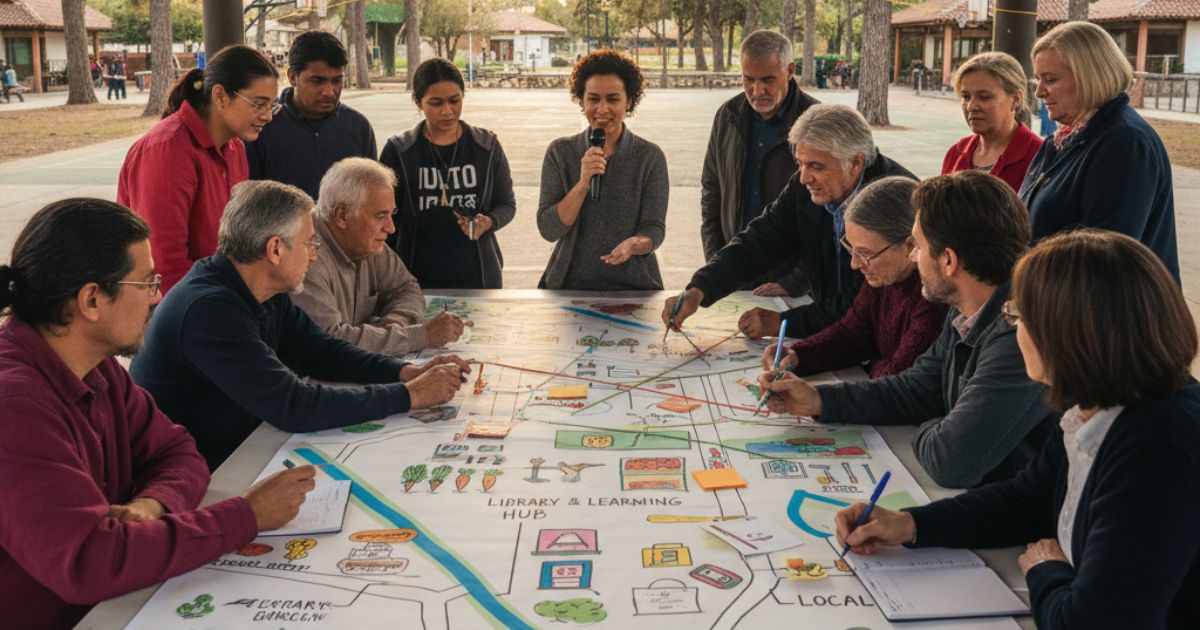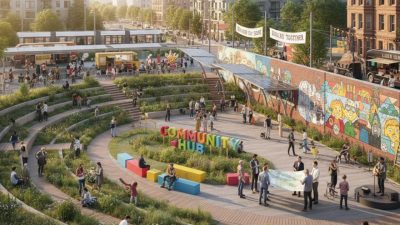In community development, lasting change occurs when local people take the lead. Participatory asset mapping enables residents to identify and utilise the strengths and resources already present within their community. Instead of focusing on problems, this approach highlights local skills, talents, organizations, and spaces that can support grassroots development. It brings together community members, NGOs, and local leaders to share ideas, build trust, and find sustainable solutions. By mapping these community assets, people gain a clearer understanding of their neighbourhood’s potential—empowering them to plan projects, attract support, and create real, positive change from the ground up.
What Is Participatory Asset Mapping?
Participatory asset mapping (PAM) is a planning tool and community engagement process that documents local assets across multiple domains. Assets can include:
- Physical infrastructure & spaces (parks, community centers)
- Local businesses & services
- Community groups, clubs, faith organizations
- Individual talents, skills, and cultural knowledge
- Natural resources, green spaces
Through facilitated workshops, walking tours, and digital mapping platforms, participants literally place pins, notes, or digital markers on a communal map. This visual inventory serves as a shared reference for planning, enabling community leaders, nonprofits, and local officials to align interventions with existing strengths and aspirations.
Key Benefits of Asset-Based Community Development

Shifting from a deficit-based mindset to an asset-based framework yields multiple advantages:
- Enhanced community ownership: Participants see themselves as change agents rather than beneficiaries.
- Stronger collaborations: Mapping uncovers informal networks and synergies among residents, organizations, and businesses.
- Resource optimization: Leaders identify underutilized facilities or talents to deploy in new initiatives.
- Positive narrative framing: Highlighting strengths boosts morale and counters negative stereotypes about neighborhoods.
- Long-term sustainability: Programs built on identified assets tend to attract local buy-in and advocacy, reducing reliance on external funding.
Step-by-Step Guide to Implementing Asset Mapping
Successful participatory asset mapping requires thoughtful design and skilled facilitation. Consider these phases:
1. Planning and Outreach
Define clear objectives: Are you aiming to revitalize a vacant lot, support a youth program, or strengthen local entrepreneurship? Identify stakeholder groups: include long-term residents, youth, seniors, local business owners, faith leaders, and municipal staff—schedule workshops at accessible times and venues. Use flyers, social media, door-to-door invitations, and trusted community ambassadors to ensure diverse attendance.
2. Asset Identification Workshops
Begin with icebreakers that surface local pride and personal stories. Provide large paper maps, markers, sticky notes, and stickers. Ask small groups to mark locations of key assets in categories such as “Places I Love,” “Hidden Talents,” or “Neighborhood Challenges.” Encourage participants to discuss why they selected each site or skill, fostering shared narratives.
3. Data Compilation & Digitization
Photograph or scan physical maps. Transfer pins, notes, and participant comments into a GIS platform or user-friendly mapping software. Tag assets by type, owner/contact, and potential uses. Supplement with demographic and land-use data to provide context for decision-making.
4. Analysis & Prioritization
Hold follow-up sessions to identify patterns, overlaps, and gaps in the data. Which areas show clusters of cultural activity? Where are physical spaces underutilized? Facilitate a prioritization exercise: vote on assets to leverage first based on impact, feasibility, and community interest.
Tools and Technologies for Modern Asset Mapping
While low-tech workshops remain effective, digital platforms can scale and sustain mapping efforts:
- OpenStreetMap: Collaborative base layers, editable by anyone.
- ArcGIS Online Community Analyst: Rich analytics and sharing features for nonprofits and governments.
- Maptionnaire: Survey-linked mapping, great for collecting resident feedback.
- Ushahidi: Crowdsourcing platform for real-time asset reporting, especially in crisis response.
- Custom Google My Maps: A familiar interface, easy to share and embed.
Choose tools based on community digital literacy, budget, and data privacy needs. Always provide training and maintain an open-access repository of mapped data.
Case Study: Revitalizing Eastwood Neighborhood Park
In the Eastwood district, a neglected pocket park once served as a hub for local youth to access mental health services. City planners partnered with a grassroots coalition to conduct an asset mapping exercise. Residents identified:
- A local artist collective willing to host murals
- An underused community center adjacent to the park
- Seniors with gardening expertise
- Businesses ready to sponsor equipment upgrades
By leveraging these assets, stakeholders co-designed a vibrant pop-up plaza with mural walls, community gardens, and a multi-generational storytelling circle. Within six months, park usage increased by 300%, and local youth reported feeling safer and more connected to the community.
Best Practices and Tips for Success

- Cultivate trust: Begin with listening sessions to honor community voices before mapping.
- Ensure inclusivity: Provide translation, childcare, transportation stipends, and accessible venues.
- Maintain momentum: Share interim maps online, solicit ongoing feedback, and celebrate quick wins.
- Safeguard privacy: Anonymize sensitive information, especially when mapping vulnerable populations.
- Plan for sustainability: Train local volunteers as mapping ambassadors to update the data regularly.
Learn More: Build Social Bond to Strengthen Relationships and Connections
Conclusion
Participatory asset mapping transforms community development from a top-down process into a co-creative journey. By documenting and celebrating existing strengths—whether physical spaces, local talents, or informal networks—residents become architects of their own future. When combined with strategic partnerships and transparent decision-making, asset mapping ignites enduring grassroots initiatives that reflect the hopes and capacities of the people they serve. Begin your mapping journey today, and watch your community flourish from within.





